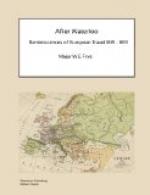Among the sights of Rome I must not omit that of a famous robber of the name of Barbone, who was the terror of the whole surrounding country from the depredations he committed. Having capitulated, and surrendered himself to the Papal Government, he is now confined in the Castle of St Angelo as a state prisoner. His wife, or a woman calling herself so, is confined there with him, and she is said to be a woman of uncommon beauty. It is quite the rage among the English here to go to see these illustrious captives, and Madame Barbone, superbly dressed, receives the hommage of the visitors. The Duchess of D[evonshire] is said to have visited her, and made her a present of a pearl necklace. I hope this is not true. Surely the Duchess, who is a woman of talent and an encourager of the fine arts, might have found some other object worthier of her munificence. What claims the mistress, or even the wife, of a public robber can have on the generosity of travellers, I am at a loss to conceive; but such is the bizarrerie and inconsequence of the English, and no doubt, be this story of her Grace of D[evonshire] having given a present true or not, it will occasion many other presents being made to the captive Princess by a host of silly lord-aping English men and women. Barbone has, it is said, made an excellent capitulation. He has stipulated to be released from prison after a year and a day’s confinement, and no doubt he will then resume his old trade of brigandage. In the meantime he has disbanded his troops, as he calls them; but will his troops obey him, now that he is a captive? will they not rather chuse another leader?
In the time of the French occupation, nothing of this kind took place; but the present Government is weak and timid. I have not been myself to see either Barbone or his wife, but I have heard quite enough about them; they form one of the principal sights in Rome, and I am quite unfashionable in not having gone to visit them; for according to the opinion of my English acquaintance, he who has not seen Barbone and his wife has seen nothing.
* * * * *
I started from Rome on the second of April with a vetturino, and on arrival at Baccano, we struck off into a road on the right hand, and arrived at Civita Castellana at a late hour. Civita Castellana merits no further attention, except that it is supposed to stand on the site of the ancient city of Veii. The following day at ten o’clock we reached the small town of Narni. Here are the remains of a beautiful bridge, constructed over the ravine, thro’ which flows the river Nera, and which was built in the time of Augustus. It affords a very favorable specimen of the Roman bridge architecture. There is a small chapel here, and it contains, engraved on a stone, a description of a miracle wrought here about four years ago by the Virgin Mary, who saved the life of a postillion. He went into the river to water




